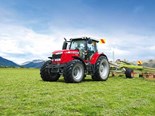Sustainability: Pasture-First farming





|

|
With help from DairyNZ tools such as the Spring Rotation Planner and DairyBase, the Ferris family has shifted to pasture-first
Just south of Taumarunui, the Ferris family runs three separate dairy units with a combined size of 670ha (effective) and 2310 cows. Robbie looks after the day-to-day running of the farm, younger brother Marc manages the run-off, and father Murray provides a wealth of knowledge and experience.
The family, who have 12 staff, had for many years been lifting their use of supplementary feed to achieve maximum production.
"There were high payouts and it seemed to make sense," Robbie says. "We were constantly being pushed to increase our production. With supplementary feed, it's perceived your cows will be healthier, in better condition, easier to get in-calf, and therefore, more profitable. Our goal was to get to 400 kilograms of milk solids/cow (kg MS) and that was easy to do with supplement so we kept doing it."
During the 2013–14 drought, the family brought in about 1.2 tonnes of feed per cow and were moving towards becoming a system 4 farm. Operating expenses were $5.60/kg MS. In April 2014, they were looking at installing in-shed feeders at each of their three dairy sheds.
"It wasn't until we sat down as a family and went through the finances in detail that we asked ourselves: 'Are we really going the right way? Is this how we want to farm? Is the profit there?'" Robbie says.
Recognising the hidden costs
Taking into account every cost associated with imported feed, such as wastage, labour, repairs and maintenance, electricity, animal health, and depreciation of machinery, the family estimated they were spending an extra 50 cents on every dollar of imported feed.
"That's a cost people often don't think about or talk about," Robbie says. "It's the secret cost of the supplementary world." That's when the family decided to change direction by cutting out most of their imported feed and relying more heavily on pasture.
Taking a team approach
They pulled their staff together and explained the new approach, sought advice from other farmers already making the all-grass system work, and took their managers to learn from a system 2 farm in Matamata.
"A system change like this needs everyone on-farm to be involved," Robbie says. "We spent time making sure everyone understood and was on board with the new approach."
The team's goal was to reach average pasture covers of 2300kg DM/ha in preparation for calving. Cow condition was good after a year of high palm kernel supplementation and that became secondary to pasture cover and a steep feed wedge.
"We had two main goals for the season and neither involved production, which is a massive leap from what we'd been focusing on," Robbie says.The first goal was to use DairyNZ's Spring Rotation Planner and not deviate from it, regardless of the conditions.
"On wet nights and days, we stood our cows off the paddocks because this related to the second goal, which was to increase our total pasture harvested on the farm. We enforced a zero-pugging policy," Robbie says. "We put our finances through DairyBase and found that after low operating costs, the strongest correlation to profit on New Zealand farms was total pasture harvested."
Without supplementary feed, the farm's production levels fell from 360–380kg MS/cow to 270–300kg MS/cow. But the family offset this loss by adding 150 more cows (across the three units) to increase pasture harvested and gain more cow days in milk by January 31.
Additionally, five per cent of the dairy units are now planted in winter crop, with all cows wintered on and heifers coming in on July 20. Through winter, animals are being fed 120kg of PKE/cow.
Enjoying the benefits
An unexpected positive was seeing their animal health bills cut in half because of lower cell counts and mastitis rates.
"The cows are not working as hard and they are in better health, and this is reflected in the empty rate, which is under 10 percent with no intervention," Robbie says."Another bonus is that our staff are enjoying better hours. There's no time spent on tractors during the milking season and their working hours are down. While the calving and mating period is as busy as it ever was, we're now able to enjoy the summer and autumn period a lot more."
The farms produced 1032kg MS/ha in the 2015–16 season, up from 950kg MS/ha in the Ferris' first year of all-grass. Although this is down from 1150–1200kg MS/ha in past years, the costs are significantly lower.
Robbie says their cows are now harvesting more grass: 13.9 tonnes in the 2014–15 season and 14.3 tonnes in the 2015–16 season, compared to 12–13 tonnes when supplements were being fed in greater quantities. "We're really happy with the move and wouldn't go back. We now have an easily-implemented farming system that works, with an operating cost structure of $3.40–$3.50/kg MS every season. The pasture-first approach made sense financially when the payout was $7. At $3.90, it really makes sense."
Robbie's top tips
- Listen to science, not salesmen
- Know your total pasture harvest. It's the backbone of your system.
- Maintain what you've learned in the downturn unless it adds to the bottom line don't put it back into the system
This article was originally published in Inside Dairy in December 2016
Keep up to date in the industry by signing up to Farm Trader's free newsletter or liking us on Facebook


.jpeg)
.jpg)
.jpeg)

.jpg)
.jpeg)
.jpg)
.jpeg)







